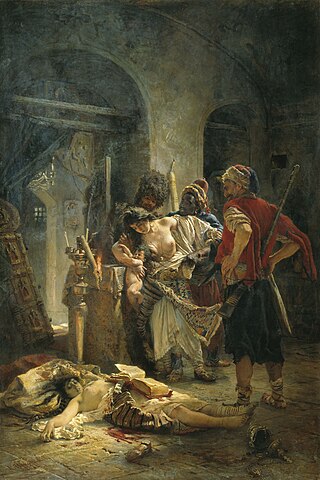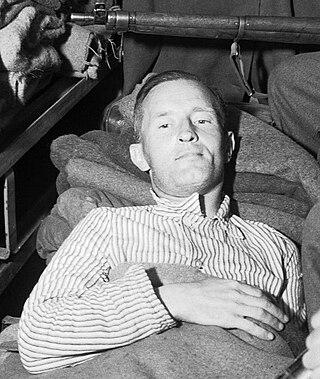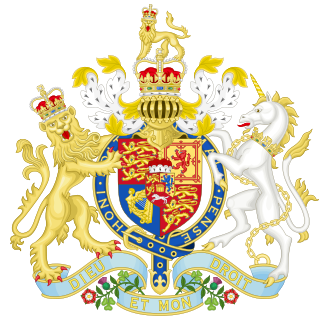
The Buggery Act 1533, formally An Acte for the punishment of the vice of Buggerie, was an Act of the Parliament of England that was passed during the reign of Henry VIII.

Sacrilege is the violation or injurious treatment of a sacred object, site or person. This can take the form of irreverence to sacred persons, places, and things. When the sacrilegious offence is verbal, it is called blasphemy, and when physical, it is often called desecration. In a more general sense, any transgression against what is seen as the virtue of religion would be a sacrilege, and so is coming near a sacred site without permission.

Under the law of the United Kingdom, high treason is the crime of disloyalty to the Crown. Offences constituting high treason include plotting the murder of the sovereign; committing adultery with the sovereign's consort, with the sovereign's eldest unmarried daughter, or with the wife of the heir to the throne; levying war against the sovereign and adhering to the sovereign's enemies, giving them aid or comfort; and attempting to undermine the lawfully established line of succession. Several other crimes have historically been categorised as high treason, including counterfeiting money and being a Catholic priest.

The Statute of Frauds (1677) was an act of the Parliament of England. It required that certain types of contracts, wills, and grants, and assignment or surrender of leases or interest in real property must be in writing and signed to avoid fraud on the court by perjury and subornation of perjury. It also required that documents of the courts be signed and dated.
Petty treason or petit treason was an offence under the common law of England in which a person killed or otherwise violated the authority of a social superior, other than the king. In England and Wales, petty treason ceased to be a distinct offence from murder by virtue of the Offences against the Person Act 1828. It was abolished in Ireland in 1829. It never existed in Scotland. It has also been abolished in other common-law countries.

The Anatomy Act 1832 is an Act of Parliament of the United Kingdom that gave free licence to doctors, teachers of anatomy and bona fide medical students to dissect donated bodies. It was enacted in response to public revulsion at the illegal trade in corpses.

Arson in royal dockyards and armories was a criminal offence in the United Kingdom and the British Empire. It was among the last offences that were punishable by capital punishment in the United Kingdom. The crime was created by the Dockyards etc. Protection Act 1772 passed by the Parliament of Great Britain, which was designed to prevent arson and sabotage against vessels, dockyards, and arsenals of the Royal Navy.
Capital murder refers to a category of murder in some parts of the US for which the perpetrator is eligible for the death penalty. In its original sense, capital murder was a statutory offence of aggravated murder in Great Britain, Northern Ireland, and the Republic of Ireland, which was later adopted as a legal provision to define certain forms of aggravated murder in the United States. Some jurisdictions that provide for death as a possible punishment for murder, such as California, do not have a specific statute creating or defining a crime known as capital murder; instead, death is one of the possible sentences for certain kinds of murder. In these cases, "capital murder" is not a phrase used in the legal system but may still be used by others such as the media.
Concealment of birth is the act of a parent failing to report the birth of a child. The term is sometimes used to refer to hiding the birth of a child from friends or family, but is most often used when the appropriate authorities have not been informed about a stillbirth or the death of a newborn. This is a crime in many countries, with varying punishments.

The Offences against the Person Act 1861 is an Act of the Parliament of the United Kingdom of Great Britain and Ireland. It consolidated provisions related to offences against the person from a number of earlier statutes into a single Act. For the most part these provisions were, according to the draftsman of the Act, incorporated with little or no variation in their phraseology. It is one of a group of Acts sometimes referred to as the Criminal Law Consolidation Acts 1861. It was passed with the object of simplifying the law. It is essentially a revised version of an earlier consolidation act, the Offences Against the Person Act 1828, incorporating subsequent statutes.

The Treason Act 1790 was an Act of the Parliament of the Kingdom of Great Britain which abolished burning at the stake as the penalty for women convicted of high treason, petty treason and abetting, procuring or counselling petty treason, and replaced it with drawing and hanging.

43 Geo. 3. c. 58, commonly called Lord Ellenborough's Act and sometimes referred to as the Malicious Shooting Act 1803 or the Malicious Shooting or Stabbing Act 1803, is an Act of the Parliament of the United Kingdom of Great Britain and Ireland.

The Offences Against the Person Act 1828 was an Act of the Parliament of the United Kingdom of Great Britain and Ireland. It consolidated provisions in the law related to offences against the person from a number of earlier statutes into a single Act. It was part of the criminal law reforms known collectively as "Peel's Acts", passed with the objective of simplifying the law. Among the laws it replaced was clause XXVI of Magna Carta, the first time any part of Magna Carta was repealed, and the Buggery Act 1533. It also abolished the crime of petty treason.

The Act 7 Will. 4 & 1 Vict. c. 85, sometimes called the Offences against the Person Act 1837, was an Act of the Parliament of the United Kingdom of Great Britain and Ireland. It amended the law relating to offences against the person. It was one of the Acts for the Mitigation of the Criminal Law passed during the session 7 Will. 4 & 1 Vict. The Legal Observer said that this Act materially lessened the severity of the punishment of offences against the person.

The Incitement to Mutiny Act 1797 was an Act passed by the Parliament of Great Britain. The Act was passed in the aftermath of the Spithead and Nore mutinies and aimed to prevent the seduction of sailors and soldiers to commit mutiny.

The Punishment of Offences Act 1837 was an Act of the Parliament of the United Kingdom of Great Britain and Ireland. It abolished the death penalty for a number of statutory offences and replaced it with transportation for life.

The Disorderly Houses Act 1751 was an Act of the Parliament of Great Britain. It made provision in relation to disorderly houses. Most of it had been repealed by the mid-twentieth century, but one section, section 8, survived until 2008.

The Piracy Act 1850, sometimes called the Pirates Repeal Act 1850, is an Act of the Parliament of the United Kingdom. It relates to proceedings for the condemnation of ships and other things taken from pirates and creates an offence of perjury in such proceedings.

The Incitement to Disaffection Act (Ireland) 1797 was an Act of the Parliament of the Kingdom of Ireland. It made equivalent provision to the Incitement to Mutiny Act 1797 for Ireland.

The Forgery Act 1837 was an Act of the Parliament of the United Kingdom. It was one of the Acts for the Mitigation of the Criminal Law passed during the session 7 Will. 4 & 1 Vict.










